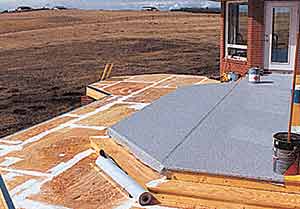Enhancing Roof Deck Performance with PVC Waterproof Membranes
Surfaces and site conditions must be ready to receive the PVC membrane, and they must conform both to the membrane manufacturer's requirements and the local building code standards. If problems are seen, the installation consultant must be notified of all conditions that would prevent satisfactory completion of work. All unsatisfactory conditions must be corrected before proceeding. Further inspection is necessary in cases where a waterproof PVC membrane is being installed over an existing system that has failed. The deck must be thoroughly inspected for rot, weakness of plywood, delamination of plywood, loose panels, or spalling concrete that may be hidden under the existing waterproofing membrane.
Once the deck surface is given the green light, the surface must be prepared. For wood decks, this mean filling in joints, knot holes, voids, and low areas with filler and sanding until a smooth surface is achieved. For Class "A" fire-rating-approved application, a plywood deck must be covered with a cementitius board that meets all requirements. For concrete decks, surface imperfections and variations must be filled with leveling compounds. It's also important to test for and remove surface contamination.
To ensure adequate adhesion, installers should glue a small test patch of the PVC membrane (about two square feet) to the existing surface. After 24 hours, the adhesion should be checked. If there are any concerns about the ability of the membrane to bond to the existing surface, the coating must be removed and the deck resurfaced with a suitable underlay.
Roof Deck Membrane Installation
The PVC membrane should be installed in accordance with the manufacturer's instructions and any appropriate PVC roof membrane application codes (for example, the CGSB -37-GP-55M). Seaming, the process of fusing two sheets of PVC membrane together, is the most critical element of a PVC waterproofing system. The vinyl sheets should be overlapped and heat fused. The membrane should be affixed to the substrate with the minimum number of seams possible. However, all seams should be extremely strong-and they should be visible. Offering invisible butt seams, as has been done in the past, was found to compromise the waterproofing, the prime function of the system.
|
To allow for a strong hot-air welded seam, adjacent membranes should overlap by a minimum of 3/4 inch. It is important to remember that proper fusing cannot take place if the back of the overlapping piece of PVC has been glued. Seam strength and integrity should be checked every few feet. If the seam comes apart, the welding is incomplete and must be redone. Extreme care must be used when welding a PVC membrane where the seam runs into a 90-degree corner and vertically up a wall or over an edge. All wall and corner seaming must be carefully inspected for pinholes. A strip of PVC may be welded on top of any critical junctions for added security.
On projects where the deck is to be used as a staging area for other trades, protective panels should be applied over the finished membrane.
Installation of a PVC membrane involves detailing that should be carefully followed. Below are installation scenarios featuring PVC and metal elements; PVC and coated metal elements; "L" trim and fully wrapped around the fascia.










